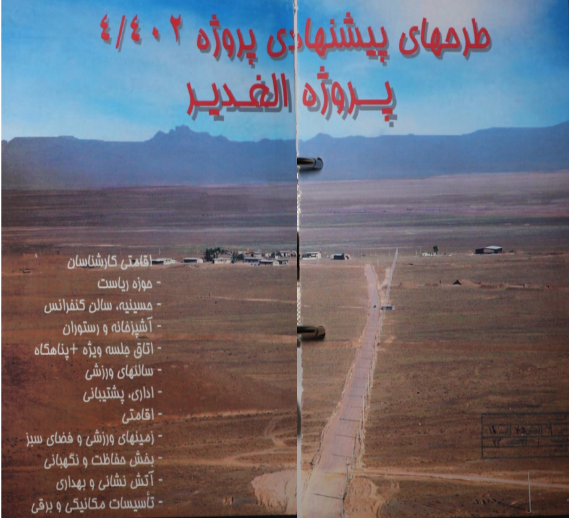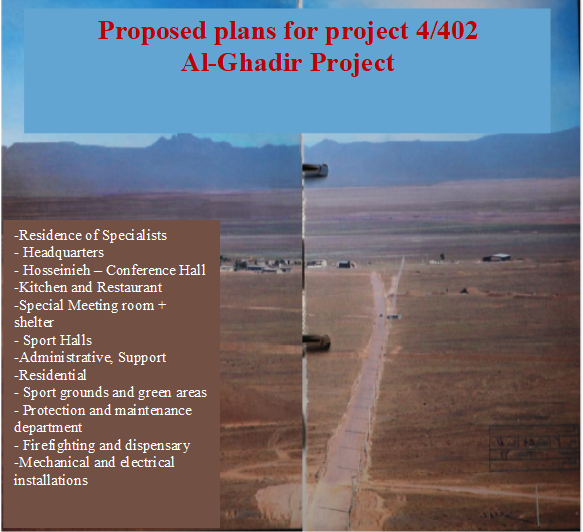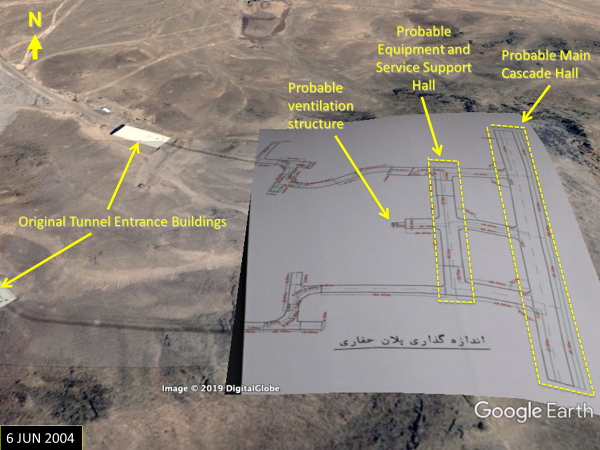Reports
Summary of Report: The Fordow Enrichment Plant, aka Al Ghadir [1] - Iran’s Nuclear Archive reveals Fordow was built originally to make weapon- grade uranium for 1-2 nuclear weapons per year
by David Albright, Frank Pabian [2], and Andrea Stricker
April 25, 2019
The Iranian “Nuclear Archive,” seized in early 2018 by Israel, contained a surprise: a photo revealing support facilities for a gas centrifuge uranium enrichment plant. The plant later became known as the Fordow Fuel Enrichment Plant (FFEP), located near Qom (Figures 1 and 2). The image in Figure 1 refers to the Al Ghadir project, which is a code name for this enrichment project under the “Amad Plan,” Iran’s early 2000s program to make five missile-deliverable nuclear weapons. Geospatial information and analysis show that this image from the archive can be dated to 2004 or earlier. The archive information shows that construction began on this once-secret plant as early as 2002, and that it was being built to produce weapon-grade uranium (enriched to over 90 percent uranium-235) as part of Iran’s nuclear weapons program. Documents in the archive show that this facility was designed to make weapon-grade uranium starting with low enriched uranium (LEU), and not natural uranium. Based on a document in the archive, the military enrichment plant was expected to produce enough weapon-grade uranium, using LEU feedstock, for at least one or two nuclear weapons per year.


Figure 1. The Al Ghadir Project Site, which is also known as project 4/402, or alternatively 4.402, where project “4.4” is an Amad designation for its secret centrifuge project and the “02” appears to be a subproject. Satellite imagery and geospatial analysis shows that this site is the support complex of the later-named Fordow enrichment plant. It should be noted that “/” in Farsi translates to a decimal “.” in American English.


Figure 2. Left: Image correlating the Al Ghadir support building construction site with the Fordow centrifuge plant. Right: Tunnel diagrams from the archive overlaid on a Google Earth image, showing how the tunnel entrances line up.
The Iranian military’s interest in gas centrifuges can be traced to the late 1980s, when the Iranian leadership created the military nuclear program and coordinated its secret gas centrifuge work with the Atomic Energy Organization of Iran (AEOI), which was also operating a variety of nuclear facilities associated with civilian nuclear energy. In the late 1990s, Iran reorganized and energized its nuclear weapons program with the establishment of the Amad Plan. A table in the archive, dated to about 2002, lists the major parts of the Amad Plan, including its centrifuge project, which started on October 2, 1999 and was originally expected to be finished by March 18, 2004.
Found in the archive is a draft document to be signed by the head of the AEOI, then headed by Reza Aghazadeh, and the Iranian Defense Ministry, then headed by Ali Shamkhani. The document orders the transfer of responsibility, and required information, methods, and budget, from the AEOI to the Defense Ministry for the task of further enriching uranium hexafluoride from three percent to over 90 percent, or weapon-grade. By skipping the step of making three percent enriched uranium, annual production of weapon-grade uranium at this facility would roughly triple. The onward enrichment, or that beyond three percent and eventually to weapon-grade, would have taken place in the Al Ghadir facility.
On September 25, 2009, then-U.S. President Barack Obama, French President Nicolas Sarkozy, and British Prime Minister Gordon Brown revealed publicly that Iran had been building a secret gas centrifuge enrichment site near Qom. This site is the Al Ghadir site.
The Al Ghadir project and its role in the Amad Plan, as far as we can determine, was not known to Western intelligence or the International Atomic Energy Agency (IAEA) prior to the seizure of the archive in early 2018. Even after this project was transferred to the AEOI sometime after 2003, several years passed before its manifestation, namely as the enrichment site near Qom, was discovered by Western intelligence.
Archive Photos and Documentation Prove that Iran Deceived the IAEA
After Western intelligence discovered the Qom site, Iran declared it to the IAEA. Iran subsequently told the IAEA that it had not started construction of the plant until 2007, claiming to have repurposed an existing military underground site on an Islamic Revolutionary Guard Corps (IRGC) base. The archive information proves this claim to be false.
At the time of its public revelation in September 2009, the United States stated it did not know if Iran designed, or planned to use, the site to produce weapon-grade uranium. However, IAEA inspectors soon came to a different conclusion. This conclusion has not been universally accepted, and some evidence contradicts it, but the inspectors’ conclusion remains the most convincing one.
Based on Iran’s statement to the IAEA, when inspectors first visited the new underground enrichment plant, they expected to find a plant that was dedicated solely to making less than five percent enriched uranium for civil purposes. Upon arrival in late October 2009, they were shown two “halls,” or portions of the deeply buried tunnel complex, which would hold centrifuges. Indeed, one hall, or portion of the tunnel complex, had centrifuge piping arrangements for cascades consistent with Iran’s declaration that LEU would be produced at the site. At that time, the centrifuges, called the IR-1, had not yet been installed, but trained inspectors can discern useful information about a cascade system by examining the piping.
Surprisingly, in the other hall, the Iranians were stripping out all the cascade piping and were cutting more rock to make additional space for what is called the feed section, namely where uranium is fed into the cascades in autoclaves, essentially ovens that heat tanks of uranium hexafluoride and turn it into in a gaseous form for injection into cascades. Iran told the inspectors that it was correcting mistakes, namely it forgot to paint the ceiling and needed bigger autoclaves. By the time of the second visit two weeks later, all the pipework had been removed.
Inspectors viewed Iran’s actions as highly suspicious for such an experienced enrichment program; after all, it had operated the Natanz enrichment plant for several years and had installed a total of 8,300 IR-1 centrifuges there by September 2009. If the second hall were for making weapon-grade uranium, going from 20 percent in two steps to 90 percent, the feed section would be relatively small, since the feed tanks and associated autoclaves would be smaller to protect against accidental criticality. However, if the cascades were designed to make less than five percent LEU, the feed tanks containing natural uranium would be relatively large and would not have fit in the existing feed section in this area, and thus this part of the plant would have had to be enlarged, if it were to be modified to make LEU. This required that a larger space be excavated from the mountain.
It appeared to some of the inspectors that Iran was hiding evidence of plans to make weapon-grade uranium in this hall and was rapidly converting the plant from making weapon-grade uranium to low enriched uranium, a level of enrichment acceptable to the international community. Moreover, the piping in the other hall designed to make LEU would have been suitable for going from three percent to 20 percent enriched uranium, and not just enriching natural to three or four percent enriched uranium.
These observations contributed to several inspectors, including ones who were experts in gas centrifuges, becoming suspicious that this hall was for the onward enrichment of uranium up to weapon-grade. Adding to their suspicions, the sizes of the feed insertion and product removal areas (“takeoffs”), visible instrumentation, and other equipment were for a lower uranium hexafluoride gas flow and higher criticality conditions than found in cascades to make low enriched uranium. The assessment was that the Iranians were going to attach feed containers to these cascades that were enriched to more than 20 percent. Some inspectors came to view that the first area was to enrich from about three to five percent to 20 percent, and the second area was to enrich in two steps from 20 to 60 percent and then 60 to 90 percent.
The archive does not contain information on the fate of the plant after the Amad project was reoriented in 2003. However, the IAEA inspector information supports that in 2009, the plant was still being built to produce weapon-grade uranium, until it was exposed and subsequently modified to make LEU under international pressure. At a minimum, this secret plant was being built to give Iran the option of producing weapon-grade uranium without the international community knowing about it.
It is known that after the Amad Plan was reoriented in 2003, the military program transferred responsibility for the Al Ghadir site to the AEOI. This handover was likely similar to the one whereby the Gchine uranium mine and mill, discussed in an earlier Institute report, went from military to AEOI control. However, with the Qom facility, the Iranians decided not to inform the IAEA about the site and subject it to monitoring until they were caught in 2009.
Transferring the Al Ghadir project to the AEOI while keeping its design to make weapon-grade uranium would be consistent with Iran’s decision to reorient the Amad Plan and downsize it, but not stop the nuclear weapons program. Building a plant designed to make weapon-grade uranium would qualify for a facility that needed to be kept secret under the reorientation plan. Undoubtedly, Iran likely calculated that if its work at the Al Ghadir enrichment site was discovered post-2004, it would deny any nuclear weapons connection, clean it up, and allow IAEA inspections. By having the AEOI own this site, the cover story of a civilian purpose would be more likely to be accepted by the international community, or at least help mitigate the costs of discovery and help ensure its operation.
Although after the 2009 exposure, Iran had to design the Fordow plant’s cascades to make LEU instead of weapon-grade uranium, it knew that with relatively minimal work it could adjust production from LEU back to weapon-grade uranium. For Iran, the Fordow site and the Gchine uranium site were too important to Iran’s effort to develop a nuclear weapons capability to shut down. Calling them civilian and allowing inspections or monitoring was undoubtedly a price worth paying.
The Fordow facility continues to operate today, although under the 2015 Joint Comprehensive Plan of Action (JCPOA), its centrifuges are not enriching uranium. A relatively small number of them are dedicated to stable isotope separation in cooperation with Russia. The U.S. and allied negotiators were not able to convince Iran to shut down this site, even though this deeply buried facility has no credible civilian nuclear justification. Moreover, Iran could reactivate the production of enriched uranium there relatively quickly, and in fact regularly threatens to do so.
Iran continues to deny that this plant was ever designed to make anything other than LEU. Today, the evidence to refute that claim rests in the Nuclear Archive. Moreover, inspector concerns and suspicions were not made public in 2009. With the new evidence, a more accurate picture of this uranium enrichment plant is possible. Nonetheless, there remain many questions, which only Iran can answer – something it should finally be expected to do.
In addition to showing Iran’s deception about its past nuclear weapons activities, the archive raises profound questions about the true purpose of this facility today and contingency plans for tomorrow. That the international community has tolerated the continued existence of this plant speaks volumes of its failure to first determine and then ensure that Iran’s nuclear program is truly peaceful.
Additional summaries of our Iran Nuclear Archive analyses can be found here.
[1] Read the full report here: David Albright, Frank Pabian, and Andrea Stricker, “The Fordow Enrichment Plant, aka Al Ghadir: Iran’s Nuclear Archive Reveals Site Originally Purposed to Produce Weapon-Grade Uranium for 1-2 Nuclear Weapons per Year,” Institute for Science and International Security, March 13, 2019. (http://isis-online.org/isis-reports/detail/the-fordow-enrichment-plant-aka-al-ghadir/)
[2] Frank Pabian is a retired Los Alamos National Laboratory (LANL) Fellow from both the Global Security and Science-Technology-Engineering Directorates, most recently in the Geophysics Group, Earth and Environmental Sciences Division, with 45 years of experience in satellite remote sensing for nuclear nonproliferation. He also served in the 1990s as a United Nations Nuclear Chief Inspector in Iraq for the IAEA.

 twitter
twitter